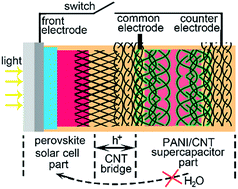A photocapacitor based on organometal halide perovskite and PANI/CNT composites integrated using a CNT bridge†
Abstract
Portable electronics powered by solar cells have become popular; however, they suffer from unstable power output of solar cells under fluctuating sunlight. Photocapacitors, integrated based on solar cells for photo-electricity energy conversion and supercapacitors for energy storage, are expected to solve the abovementioned problem. Organometal halide perovskite solar cells (PSCs) have rapidly achieved a high power conversion efficiency (PCE) of 22.1%. On the other hand, polyaniline/carbon nanotube composite supercapacitors (PANI/CNT SCs) with an aqueous gel electrolyte have shown excellent energy storage performance. It's attractive to develop high-performance photocapacitors based on PSCs and PANI/CNT SCs, but is quite challenging because water from the aqueous electrolyte may get through the hydrophilic PANI/CNT to the PSCs and boost the degradation of the PSC absorber. In this study, a photocapacitor was integrated based on a PSC of CH3NH3PbI3 (MAPbI3) as an absorber and a PANI/CNT SC by fabricating a CNT bridge between the PSC part and the SC part. Owing to the large pseudocapacitance and great conductivity of the PANI/CNT electrode, this device showed a large specific area capacitance of 422 mF cm−2 (or specific mass capacitance of 103.4 F g−1), high coulombic efficiency of 96%, overall energy storage efficiency of 70.9%, and stable power output under complex illumination conditions such as fluctuating sunlight. Photocapacitors designed in this study provide a reference for the development of high-performance photocapacitors with a large capacitance.



 Please wait while we load your content...
Please wait while we load your content...